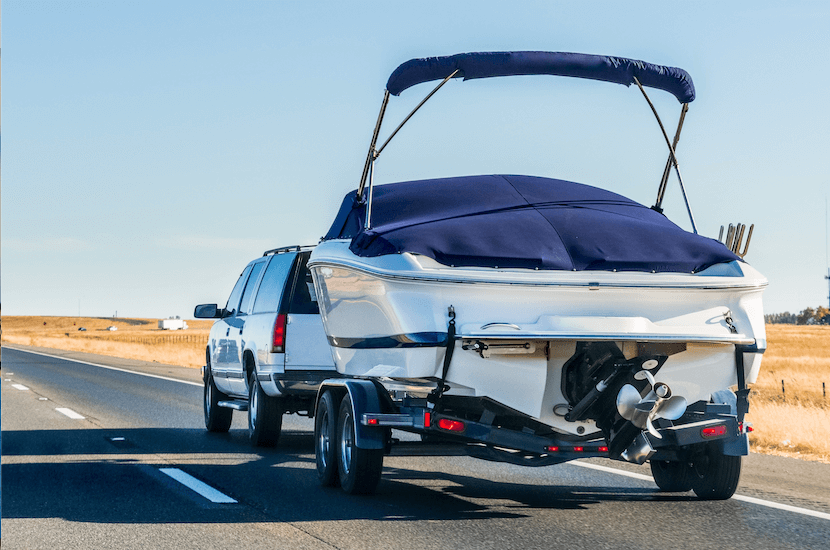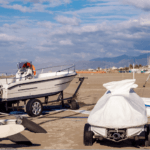
Your Go-to Boat Maintenance Checklist: Prepping your Boat and Trailer for the Season
Initial Preparations
- Storage and Dewinterizing: Ensure that the boat trailer is stored in a location shielded from harsh weather conditions to prevent damage. Follow the manufacturer’s guidelines for dewinterizing the boat engine, which includes charging and installing the battery, adding fresh gas, and checking both navigational and trailer lights.
- Engine and Maintenance Checks: Service the engine thoroughly—this involves checking water pumps, thermostats, oil and gas filters, and fluid levels. It’s crucial to replace the engine oil, lower-unit oil, and water-separating fuel filter to ensure optimal performance.
Cleaning and Painting
- Hull Cleaning and Painting: Start by applying Hull and Bottom Cleaner at the scum line and rinse the boat thoroughly with fresh water. Then, jack up the boat off the trailer for easier access and apply a fresh coat of ablative multiseason, water-based antifouling paint, ensuring compatibility with your paint manufacturer.
- Finishing Touches: For a more durable and aesthetically pleasing finish, consider using a spray-on ceramic finish instead of traditional carnauba wax. This can also be applied to the engine to maintain its appearance. Ensure all grease fittings on the engine and tilt mechanism are well-lubricated.
Electronics and Upholstery Care
- Electrical and Operational Checks: Perform checks on the transducer to ensure it aims straight down and apply transducer antifoulant if the boat remains in water all season. Double-check the coaxial cable antenna connection to your VHF radio and perform a radio check, avoiding the use of Channel 16.
- Upholstery and Vinyl Maintenance: Use snap-and-zipper lubricant to maintain smooth operation of snaps and zippers. Regularly check and clean clear vinyl windows in your canvas. For vinyl upholstery, apply 3M Vinyl Conditioner & Protector monthly. For exterior wood elements, a light sanding followed by varnishing every two seasons is recommended to preserve their condition and appearance.
Boat and Trailer Inspection
Regular maintenance of your boat and trailer is essential to ensure safety and prevent unexpected failures. Begin by conducting a thorough inspection of the boat trailer, which should be ideally suited for its environment; for instance, saltwater trailers should be specifically designed to resist corrosion. Check the tires for any signs of wear such as punctures, splits, or low tread depth, as these can significantly impact traction and braking. Additionally, inspect the axles and brakes for any damage or unusual noises during operation, which might suggest the need for immediate repair or replacement.
Comprehensive Trailer and Boat Systems Check
- Axles and Suspension: Monthly inspections of the axles for rust and damage are crucial, especially after exposure to harsh conditions. Look for signs of wear or damage on the springs, shocks, shackles, and winches, and replace any compromised parts promptly.
- Brakes and Bearings: Service the trailer brakes and surge-brake actuator before any major trip to avoid overheating and ensure smooth operation. Wheel bearings should be packed with fresh lubricant and capped with a protector. Regular greasing of bearings every 6-12 months is recommended, with more frequent maintenance in harsh environments.
- Lights and Electrical Systems: Ensure all lighting systems including running, brake, clearance, and turn signals are functional to avoid fines and ensure safety on the road. Inspect all on-board electrical devices and connections for proper functioning and signs of corrosion.
Structural and Safety Equipment Inspection
- Hitch and Safety Features: Regularly check the hitch ball and safety chains for any signs of wear or damage. Ensure the chains are securely attached to the tow vehicle’s trailer hitch. Grease the trailer ball and coupler with marine grease for durability and smooth operation.
- Winch and Straps: Inspect the winch, bow-winch strap, bow safety chain, and transom straps for integrity and proper operation. Lubricate moving parts of the winch and support systems annually with marine-grade lubricant to prevent rust and ensure smooth functionality.
- Frame and Chassis: Examine the trailer’s frame and components for rust, corrosion, or discoloration. Pay particular attention to leaf springs and brackets, which can corrode during seasonal storage, and replace any damaged or worn parts immediately.
This systematic approach to inspecting and maintaining your boat and trailer not only ensures a safe and smooth operation but also prolongs the lifespan of your marine equipment.
Maintenance and Repairs
Engine and System Maintenance
- Regular Engine Checks: Start by inspecting the engine for any signs of leaks, loose hoses, or belts. It’s essential to check and replace the engine oil and oil filter as needed to ensure efficient operation.
- Cooling System Maintenance: Keep the cooling system clear of debris and check the coolant level regularly. This prevents overheating and maintains engine performance.
- Battery Care: Ensure the battery is functioning correctly by checking electronics and lights. Connect it to a maintenance charger to help extend its life, especially during colder months when cold weather can shrink caulk, necessitating fresh application around decks and casting platforms.
Structural and Mechanical Integrity
- Bearings and Lubrication: Grease wheel bearings periodically to prevent shrinking and check for saltwater damage, which is common. Repacking wheel bearings should be done more frequently if the boat is used in harsh conditions.
- Bolt and Fastener Security: Before each outing, and at regular intervals (every 20, 50, and 100 hours of use, and before layup), check transom mounting bolts, jack plate bolts, and ensure all accessible bolts/fasteners are torqued correctly to avoid any structural failures.
Comprehensive Pre-Outing Checks
- Propeller and Skeg Inspection: Inspect the propeller and skeg for any damage before each outing. This is crucial for maintaining proper navigation and performance of the boat.
- Hydraulic and Mechanical Systems: Regularly check hydraulic systems for fluid levels and leaks, and bleed the system as necessary. For mechanical systems, ensure there is no kinking or binding, and lubricate all necessary points to ensure smooth operation.
These steps are part of a rigorous boat maintenance checklist that should be followed diligently to ensure safety and extend the life of the boat and its components. Regular maintenance not only helps in keeping the boat in top condition but also ensures that it remains ready for the water at any time.
Cleaning and Organization
Essential Cleaning Tips
- Surface and Hardware Cleaning: Begin by removing surface rust from fiberglass using a paste made from water and baking soda. This gentle yet effective method ensures no damage to the surface. For tougher stains like road tar and asphalt on hulls, an oven cleaner can be applied carefully followed by a thorough rinse.
- Interior Maintenance: Inspect cabinets and other storage areas for signs of infestation or mold. Use a pressure washer with mild soap to clean wood surfaces, maintaining their luster and preventing buildup of dirt and grime.
Organization Strategies
- Storage Solutions: Utilize silicone caulk to create a nonskid bottom for dishes in storage areas, preventing movement and potential damage. Document the disassembly process of complex gear using a camera and masking tape to keep track of parts, ensuring easy reassembly. For efficient space management, use cheap plastic food containers for mixing two-part epoxy; these can be easily discarded after curing, reducing cleanup time.
- Drainage Maintenance: Employ a plastic sink liner as a strainer in the cockpit to prevent leaves from blocking drains. Additionally, a commercial hair strainer or light mesh can be used to prevent hair and other debris from clogging drains.
Seasonal Preparation and Maintenance
- Pre-Season and Post-Season Care: Thoroughly clean the boat before storing, which includes the hull, propellers, shafts, and interior cabinets. Apply a protective wax or polish to the hull and deck periodically, especially before storage and after extensive use. Ensure the bilge is clean and dry to prevent moisture accumulation and odors.
- Protective Measures: Cover trailer tires with tire covers or store indoors to protect from UV damage and extend their lifespan. Rinse off trailers and boats with a lawn sprinkler after outings to remove salt and dirt, preserving the finish and preventing corrosion.
Safety Gear and Legal Requirements
Essential Safety Gear Compliance
- Life Jackets and Throwable Devices: Every boat must be equipped with U.S. Coast Guard-approved life jackets (Personal Flotation Devices, PFDs) for each person on board. For children under the age of 12 or 13 (depending on the state), these life jackets must be worn at all times. Additionally, a throwable flotation device (Type IV PFD) is required on all boats, ensuring safety in emergencies.
- Fire Safety and Distress Signals: Ensure your boat carries the appropriate fire extinguishers, typically at least one 5-B or 10-B, depending on the boat’s age and size. Visual distress signals for day and night use and sound signaling devices are mandatory for enhancing safety during adverse conditions.
- Navigation and Documentation: All recreational vessels must have operational navigation lights for use from sunset to sunrise. A valid Certificate of Number should be on board at all times, alongside ensuring compliance with minimum ventilation requirements for older boats.
Recommended Additional Safety Equipment
- Communication and Emergency Supplies: While not always legally required, having a VHF radio, a comprehensive first aid kit, and additional safety tools like a manual bailing device and waterproof flashlight can be vital in emergencies. It’s advisable to include extra dock lines, spare fuses, spark plugs, and belts to prepare for unexpected situations.
- Preventative Measures and Gear Maintenance: Regular checks of safety gear are crucial. This includes ensuring life jackets fit all potential passengers and checking the expiration dates on flares and the charge levels on fire extinguishers. A well-stocked boat increases the chances of a safe return from every voyage.
Customizable Safety Checklist
- Routine Safety Inspections: Implementing a customizable boat safety equipment checklist is essential. This checklist should be adapted based on specific state and country requirements and can include attachments of reference files for compliance verification. It should also allow for the tallying of all available safety supplies, identification of items in low stock or needing replacement, and the creation of prioritized action items. Regular updates and sharing of this checklist help maintain high safety standards and ensure all equipment is up-to-date and in good working condition.
Ready for Launch
Before approaching the boat ramp, ensure the engine is prepared by using a motor flusher connected to a water hose. This step is crucial to confirm that the engine starts smoothly and is ready for operation. Additionally, install the drain plug and remove all safety straps to prepare for the launch. It’s advisable to have a plan in place and conduct a brief inspection for leaks or other issues that could affect the launch process.
- Positioning and Launching the Boat:
- Drive up next to the boat landing, aligning parallel with the shoreline.
- Turn the vehicle so that it and the trailer are perpendicular to the water’s edge.
- Back the vehicle and trailer toward the water, using a friend to guide or proceeding slowly if solo.
- Keep the trailer straight, monitoring the surroundings for other vehicles and people.
- Gently apply the brakes as you back down the ramp, stopping to keep the tongue and boat winch out of the water.
- Release the boat gradually, ensuring the trailer winch line remains connected and tight until the boat begins to float.
- Final Steps in the Launch Process:
- Attach a tow rope to the boat, securing it to a dock cleat or having a friend hold onto it.
- Continue to back up until the stern floats, then guide the boat away from the trailer using the tow rope.
- Once clear, disengage the vehicle’s emergency brake and drive forward away from the water.
- Park the vehicle and trailer in a designated area, ensuring all equipment is stowed properly and the launch area is clear for others.
Throughout the launch, maintain awareness of overhead power lines and ensure all straps and safety chains are removed before the boat enters the water. By following these steps, the boat will be well-prepared for a safe and enjoyable boating season.
Last but not least, make sure your boat and trailer insurance are up to date. The last thing you want is to have an issue on the road or at the launch and find out your insurance is not “up to par”. Call Safety Northeast Insurance Agency with any boat or trailer questions!
Have a great season on the water this year!
FAQs
- How should I prepare my boat for a new season?To prepare your boat for the season, start with a thorough cleaning of the hull, deck, and topsides. Ensure all drains are clear of blockages. Wash the boat thoroughly and apply a coat of wax to protect the paint. Additionally, clean and oil any wood finishes, and make sure fixtures such as windows, hatches, and blinds are clean.
- What ongoing maintenance does a boat require?Routine boat maintenance should include checking and topping off all fluid levels, inspecting the battery’s condition, and looking for signs of corrosion or oxidation. Regularly service your transmission as per the manufacturer’s guidelines and maintain a clean and functional engine.
- What checks are crucial at the start of the boating season?At the beginning of the boating season, it’s important to assess the boat’s condition thoroughly. Check for fuel leaks from the tank, fuel lines, and carburetor. Examine the propulsion and cooling systems, check the oil level, and inspect the engine compartment for any oil leaks. It’s also advisable to change the oil filter, water filter, and spark plugs if necessary.
- What are the general maintenance recommendations for boats?For general boat maintenance, it’s recommended to inspect all fluid levels and oil levels before every voyage. Check the condition of your battery and look for any signs of corrosion or oxidation. Preventative measures should be taken to address these issues early. Additionally, follow the manufacturer’s recommendations for servicing your transmission.

 Previous Post
Previous Post Next Post
Next Post